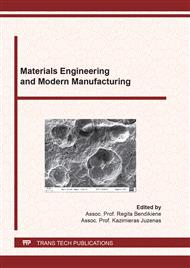p.119
p.126
p.131
p.139
p.144
p.150
p.155
p.161
p.169
Wear Behavior of Ceramic-Metal Composites as Tool Material for FSW of Copper
Abstract:
Friction stir welding (FSW) is employed primarily for metals characterized by poor weldability at fusion welding: aluminium, magnesium, titanium and copper alloys as well as stainless steels. The focus of the study was on the feasibility of application of WC-based hardmetal 85WC-Co and TiC-based cermet 80TiC-NiMo as potential tool materials for FSW of copper. The single-pass welding trials of Cu sheets were performed using a vertical milling machine. For better understanding of interactions between the tool and workpiece at welding temperature EDS line scans across the interfaces tool-workpiece after welding as well as after diffusion tests were performed. It was concluded that both tested ceramic-metal composites did not failure during multiple plunges and during the total transverse welding distance of 10 m. Also, significant tool wear was not observed after such a welding distance. The possibility of producing visually defect-free welds using tools from WC- and TiC- based ceramic-metal composites was proved and also mutual diffusion of elements across the interface tool-workpiece was discussed.
Info:
Periodical:
Pages:
144-149
Citation:
Online since:
June 2021
Authors:
Keywords:
Price:
Сopyright:
© 2021 Trans Tech Publications Ltd. All Rights Reserved
Share:
Citation:


